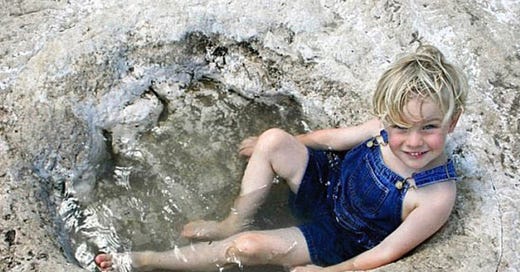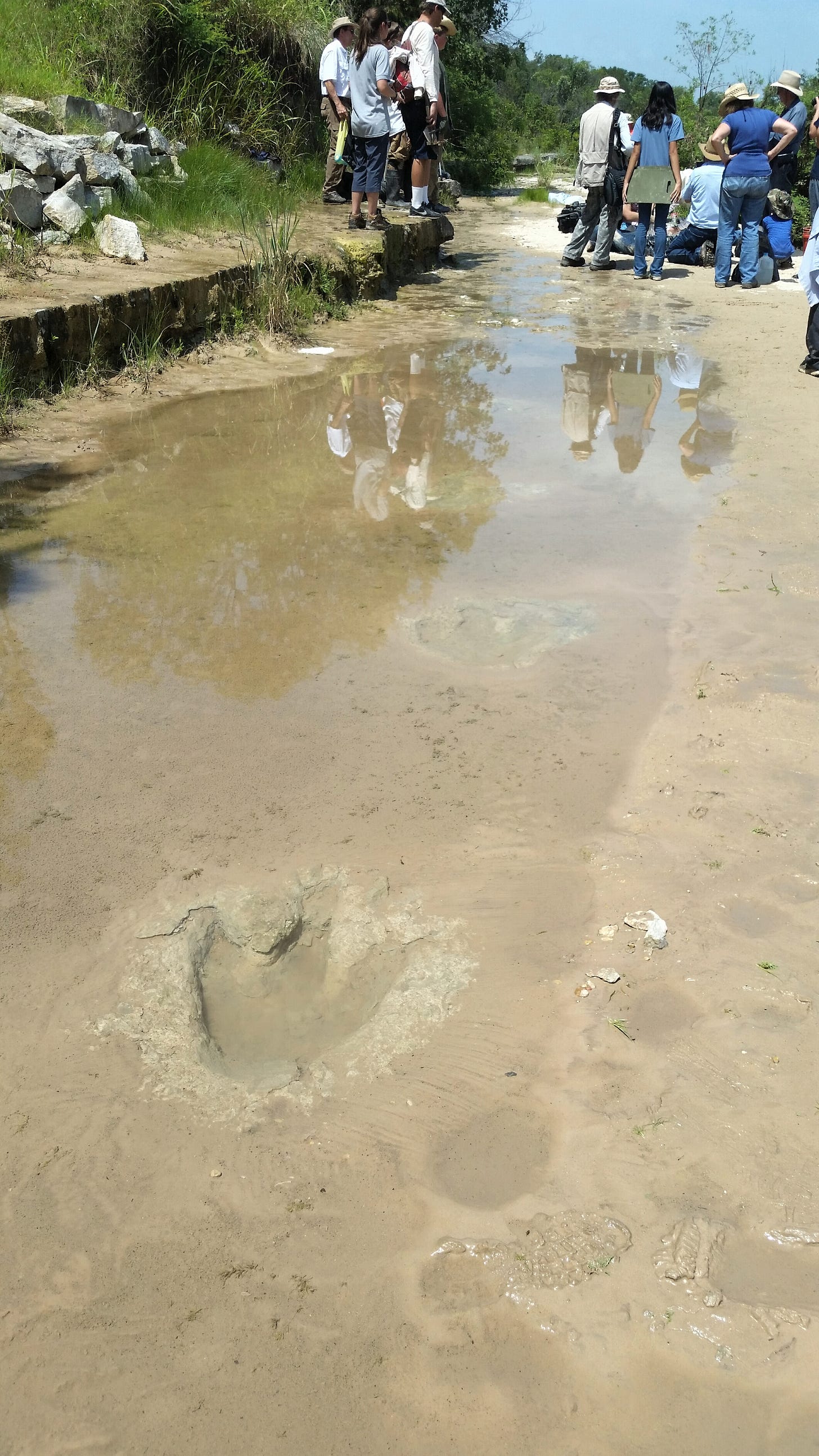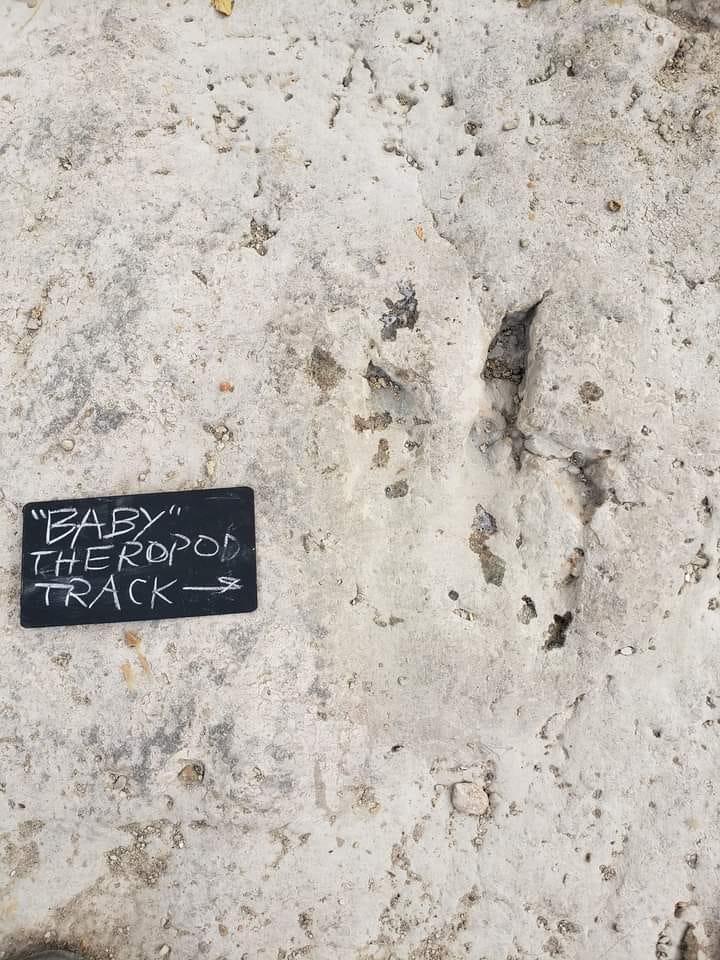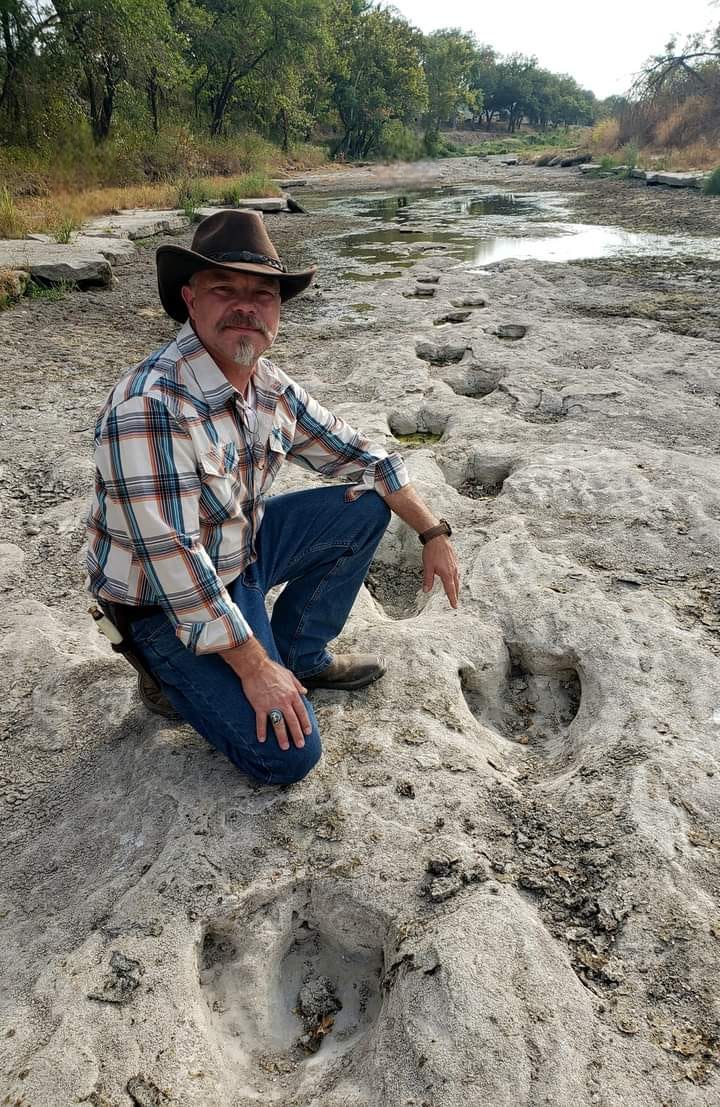Tannon Judkins sitting in a large Sauropod dinosaur track- Glen Rose, TX
How Did Dinosaurs Leave Tracks in a Flood?
As the floodwaters oscillated due to shifting tectonic forces, land would have been temporarily exposed. This would allow dinosaurs—many of which were likely struggling to survive—to climb onto temporarily dry land and leave footprints.1
Supporting evidence for this model:
The rising and falling floodwaters would expose land for short periods, just enough time for dinosaurs to leave tracks before being swept away again.
The footprints would quickly be covered by more sediment, ensuring their preservation.
Some tracks were likely made by partially submerged dinosaurs struggling in shallow waters, similar to how elephants react to rising floodwaters today.2
Why Do We Find Tracks Below Fossilized Dinosaur Bones?
One consistent observation in the fossil record is that dinosaur tracks are found in layers below the fossils of actual dinosaur bodies. This fits perfectly within a Flood model, where:
Dinosaurs made tracks on briefly exposed land during early stages of the Flood.
Later waves of sediment rapidly buried the tracks.
As the Flood progressed, dinosaurs that failed to find refuge drowned and were buried in higher layers.3
If the tracks and bones had been formed millions of years apart, as evolutionary geologists claim, we should expect a far more chaotic distribution of fossils. Instead, what we observe fits the biblical Flood narrative.
Dinosaur Trackways: What Do They Reveal?
Fossilized dinosaur tracks have been discovered in sedimentary rock layers across the world. Evolutionary scientists typically interpret these tracks as evidence of normal animal behavior from over 100 million years ago. However, the biblical account states that all land-dwelling animals not aboard Noah’s Ark perished in the Flood (Genesis 7:22). If this is true, then how do we explain the existence of dinosaur trackways?
A closer look at the nature of these tracks provides several key insights that align more closely with a Flood model than with an evolutionary timescale.
Tracks Only Found on Flat Bedding Planes
Another intriguing feature of dinosaur trackways is that they are found almost exclusively on flat sedimentary surfaces. Evolutionary geologists argue that these tracks were preserved gradually over long periods, yet if this were true, we would expect tracks to be found on multiple layers of various elevations, including hilly terrain and valleys.
Instead, tracks are consistently found on flat bedding planes, suggesting rapid sediment deposition and subsequent exposure before being buried by another flood layer. This is exactly what we would expect in a catastrophic Flood scenario, where:
Floodwaters receded temporarily, exposing freshly deposited sediment.
Dinosaurs, desperate for high ground, traversed these surfaces, leaving tracks.
Another surge of floodwaters quickly buried the tracks, preserving them.
The recent discovery of dinosaur tracks in England follows this pattern, further reinforcing the Flood model.4
How Could Tracks Form in a Global Flood?
At first glance, it may seem contradictory that dinosaurs left tracks while floodwaters were covering the earth. However, the Flood was a dynamic event, with waters rising and falling due to tectonic activity, oceanic currents, and shifting landmasses.
Geophysicists John Baumgardner and Daniel Barnette modeled ocean circulation during a global flood and found that strong currents of up to 180 mph would have rapidly swept across submerged continents.5 These forces would have caused fluctuating sea levels, exposing land intermittently.
In western North America, for instance, the early Flood likely created a deep basin. As the basin filled with sediment, the rising seabed would have exposed temporary landmasses where dinosaurs left their tracks before being overwhelmed once more by rising waters.
Multiple Layers of Dinosaur Prints
Some fossil sites contain tracks on multiple bedding planes—which may seem problematic for a Flood model. For example, in the Jindong Formation, South Korea, over 100 dinosaur trackways have been discovered on multiple thin sedimentary layers 300-600 feet (100–200 meters) thick!6
However, this does not contradict the Flood model. If the sea level was oscillating, it would have forced dinosaurs to move back and forth, leaving tracks on multiple layers of freshly deposited sediment.
Evolutionists interpret these layers as forming over millions of years, yet the similarity of tracks at each level suggests they were all made by the same species in a short time span. If millions of years had passed, we would expect a diverse range of trackmakers, not a repeated pattern of the same species. This strongly supports a Flood-based interpretation.
Final Thoughts
Fossilized dinosaur footprints in dolomite layers create a major dilemma for evolutionary geologists, who struggle to explain how land-dwelling dinosaurs left tracks in a rock type associated with marine conditions.
However, when viewed through the lens of biblical history, the explanation becomes clear:
The Flood’s catastrophic forces rapidly transported marine sediments onto the land, creating conditions necessary for dolomite formation.
The rising and falling floodwaters temporarily exposed surfaces where dinosaurs left their tracks.
The quick burial of tracks preserved them before erosion could destroy them.
The subsequent drowning of dinosaurs explains why their body fossils appear in higher layers.
By taking God’s Word as the foundation for understanding Earth’s history, the mystery of fossilized dinosaur footprints is not only solved—it provides further confirmation of the biblical Flood account.
The formation of dinosaur tracks during a global flood might initially seem paradoxical. If the earth was completely inundated, how could dinosaurs leave footprints in sediment? A closer examination of the details, however, suggests that the Flood provides a compelling explanation for the widespread occurrence of fossilized dinosaur tracks.
Dinosaur trackways present several unusual characteristics that challenge evolutionary explanations:
Straight trackways suggest dinosaurs were fleeing a catastrophe, not engaging in normal daily activity.
Tracks are found only on flat bedding planes, which is inconsistent with gradual sedimentation over millions of years.
The dynamic nature of the Flood, with fluctuating sea levels, explains how dinosaurs could leave tracks before being overtaken by water.
Trackways on multiple layers suggest repeated cycles of exposure and burial, not millions of years of slow accumulation.
Rather than being a challenge for the Flood model, dinosaur trackways provide strong supporting evidence for the global catastrophe described in Genesis. Once we examine the data through a biblical lens, the fossilized tracks of dinosaurs become a powerful testament to the reality of Noah’s Flood.
Footnotes
Wise, K. P. (2002). Faith, Form, and Time. Broadman & Holman Publishers, pp. 170–175.
Brown, J. H., & Gibson, A. C. (1983). Biogeography. The C. V. Mosby Co., p. 314.
Brand, L. R., & Florence, J. (1982). Stratigraphic Distribution of Vertebrate Fossil Footprints Compared with Body Fossils. Origins.
Lockley, M.G. (1991). Tracking Dinosaurs—a New Look at an Ancient World. Cambridge University Press, pp. 136–138.
Barnette, D.W., & Baumgardner, J.R. (1994). Patterns of ocean circulation over the continents during Noah’s Flood. Proceedings of the Third International Conference on Creationism, pp. 77–86.
Lockley, M.G., & Hunt, A.P. (1995). Dinosaur Tracks and Other Fossil Footprints of the Western United States. Columbia University Press, p. 165.
Thank you for reading Dr. Aaron Judkins Substack.
As a token of our appreciation, we're offering you a limited-time offer of 20% off a paid subscription for your first year.
Here are the benefits you unlock with a paid subscription:
Subscriber-only posts and full archive
Post comments and join the community
Thanks again for reading.
PS. If you loved this article, be sure to head over to our Ancient Pathways Patreon site and see my presentation on “Dinosaur Trackways”, the video “Dinosaur Pictograph: Kachina Bridge”, or the film “Forbidden History of Dinosaurs”. And be sure to check out our “Out of Place Artifacts” Digital Library!








